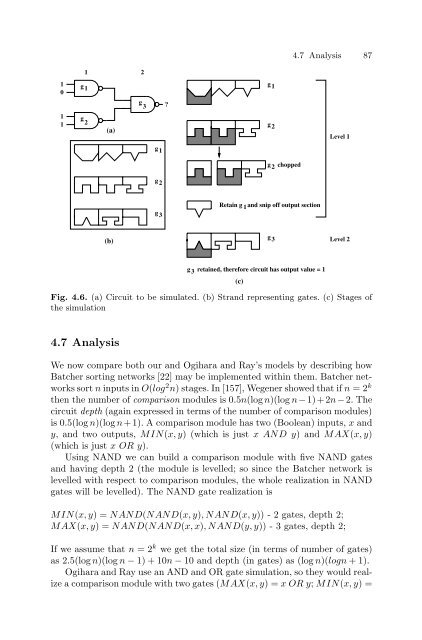Theoretical and Experimental DNA Computation (Natural ...
Theoretical and Experimental DNA Computation (Natural ...
Theoretical and Experimental DNA Computation (Natural ...
Create successful ePaper yourself
Turn your PDF publications into a flip-book with our unique Google optimized e-Paper software.
1<br />
0<br />
1<br />
1<br />
g 1<br />
g<br />
2<br />
1 2<br />
(a)<br />
(b)<br />
g 3<br />
g 1<br />
g 2<br />
g 3<br />
?<br />
(c)<br />
g 1<br />
g 2<br />
g 2 chopped<br />
Retain g 1 <strong>and</strong> snip off output section<br />
g 3<br />
g 3 retained, therefore circuit has output value = 1<br />
4.7 Analysis 87<br />
Level 1<br />
Level 2<br />
Fig. 4.6. (a) Circuit to be simulated. (b) Str<strong>and</strong> representing gates. (c) Stages of<br />
the simulation<br />
4.7 Analysis<br />
We now compare both our <strong>and</strong> Ogihara <strong>and</strong> Ray’s models by describing how<br />
Batcher sorting networks [22] may be implemented within them. Batcher networks<br />
sort n inputs in O(log 2 n) stages. In [157], Wegener showed that if n =2 k<br />
then the number of comparison modules is 0.5n(log n)(log n−1)+2n−2. The<br />
circuit depth (again expressed in terms of the number of comparison modules)<br />
is 0.5(log n)(log n+1). A comparison module has two (Boolean) inputs, x <strong>and</strong><br />
y, <strong>and</strong> two outputs, MIN(x, y) (whichisjustxANDy)<strong>and</strong>MAX(x, y)<br />
(which is just xORy).<br />
Using NAND we can build a comparison module with five NAND gates<br />
<strong>and</strong> having depth 2 (the module is levelled; so since the Batcher network is<br />
levelled with respect to comparison modules, the whole realization in NAND<br />
gates will be levelled). The NAND gate realization is<br />
MIN(x, y) =NAND(NAND(x, y),NAND(x, y)) - 2 gates, depth 2;<br />
MAX(x, y) =NAND(NAND(x, x),NAND(y, y)) - 3 gates, depth 2;<br />
If we assume that n =2 k we get the total size (in terms of number of gates)<br />
as 2.5(log n)(log n − 1) + 10n − 10 <strong>and</strong> depth (in gates) as (log n)(logn +1).<br />
Ogihara <strong>and</strong> Ray use an AND <strong>and</strong> OR gate simulation, so they would realize<br />
a comparison module with two gates (MAX(x, y) =xORy; MIN(x, y) =







